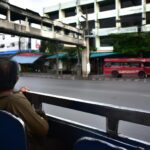Urbanization leads to environmental challenges like pollution and loss of green spaces, affecting residents’ well-being. Communities face increased traffic congestion, noise pollution, and higher costs of living in urban areas. As cities grow, social inequality can worsen, with marginalized groups facing barriers to resources and opportunities. Urbanization also strains infrastructure like water and sanitation systems, impacting public health. However, cities offer diverse cultural experiences and economic opportunities, attracting people seeking a better life. Balancing the benefits and challenges of urbanization is essential to create inclusive and sustainable communities for all residents to thrive together.
Table of Contents
- Causes of urbanization
- Changes in economic activities
- Effects on infrastructure
- Environmental impact
- Social inequality
(Impacts of Urbanization| AP Environmental science| Khan Academy)
Urbanization is transforming societies globally, reshaping the way people live and interact with their environment. Increased migration to cities has led to the rapid growth of urban populations, putting immense pressure on infrastructure and resources. This trend has significant social repercussions, affecting various aspects of daily life.
One notable impact of urbanization is the rise of slums and informal settlements, where a large segment of the urban population resides in substandard housing conditions. This lack of proper housing exacerbates issues of poverty, crime, and health disparities, contributing to societal inequalities.
On the other hand, urbanization has also brought about positive changes in social dynamics. Cities provide opportunities for cultural exchange, innovation, and economic growth, attracting diverse populations with varying backgrounds and perspectives. This multicultural environment fosters creativity and collaboration, leading to social advancement and community development.
Nevertheless, the rapid pace of urbanization has its challenges. As cities expand, there is a strain on basic services such as transportation, healthcare, and education. This strain can widen the gap between the rich and the poor, leading to social unrest and discontent among marginalized communities.
In conclusion, the social impact of urbanization is multifaceted, encompassing both positive and negative consequences. It is crucial for policymakers and urban planners to address the challenges of rapid urban growth while harnessing the potential benefits of a dynamic and diverse urban landscape for the betterment of society.
Causes of urbanization
Urbanization occurs due to factors like rural-urban migration, industrialization, and economic opportunities in cities. Population growth and job availability push people to urban areas, leading to a shift from rural to urban living. The quest for better living standards and access to essential services contributes to urbanization. Improved healthcare facilities, education options, and infrastructure in cities attract individuals from rural areas. The allure of a more comfortable lifestyle and higher income potential in urban settings drives urbanization. As urban centers offer various employment opportunities in diverse sectors, people move seeking better livelihoods. Environmental factors like natural disasters and climate change can also influence urbanization patterns. Displacement caused by floods, droughts, or other disasters can force people to relocate to cities. Social factors such as social mobility and cultural exchange play a role in urbanization. Cities provide platforms for cultural exchange, education, and exposure to diverse perspectives. This cultural interchange adds to the urbanization process as people seek new experiences. Technological advancements contribute to urbanization by creating new job markets in urban areas. The demand for skilled labor in technology and innovation sectors attracts individuals to cities. Globalization leads to urbanization trends as cities become hubs for international trade and commerce. The interconnectedness of economies drives urban growth and development in various regions. Urbanization can result in social challenges like overcrowding, inequality, and strain on resources. As cities expand, issues of housing shortage, traffic congestion, and pollution arise, impacting urban dwellers. However, urbanization also brings opportunities for social development, innovation, and cultural enrichment. Cities serve as centers for creativity, entrepreneurship, and social progress, shaping the future of society. Overall, urbanization is a multifaceted phenomenon influenced by various factors that shape the social landscape.
Changes in economic activities
Urbanization has led to significant transformations in economic activities. As rural areas are depopulated, urban centers become hubs for commerce and industry. There is a shift from agrarian-based economies to service-oriented sectors in urban settings. The demand for goods and services increases with a growing urban population. This creates new job opportunities in various sectors such as retail, finance, and technology. As urban areas expand, so do opportunities for entrepreneurship and innovation. The rise of urban centers fosters economic growth and development in surrounding regions. However, this shift also brings challenges such as income inequality and access to resources. Urbanization can lead to disparities in wealth distribution within a society. Some individuals may benefit greatly from urban economic activities while others struggle to make ends meet. Social programs and policies are needed to address these inequalities and ensure equitable access to economic opportunities. Overall, the changes in economic activities resulting from urbanization have both positive and negative impacts on society. It is essential to carefully manage these changes to promote sustainable and inclusive economic growth.
Effects on infrastructure
Urbanization significantly impacts infrastructure, affecting essential services like transportation, utilities, and communication networks. Growing cities face challenges in maintaining and expanding these vital systems to meet the increasing demands of a larger population. Roads, bridges, and public transportation often bear the brunt of heavy traffic, leading to wear and tear that necessitates frequent repairs and upgrades. As more people flock to urban areas, the strain on water supply and sanitation systems intensifies, resulting in issues such as water shortages and inadequate waste management. The deteriorating quality of air and water due to pollution poses health risks to residents and puts pressure on healthcare facilities to address related illnesses. Furthermore, the rapid pace of urbanization can outstrip the capacity of emergency services, impacting response times and overall effectiveness in times of crisis.
In developing countries, the disparity in infrastructure development between urban and rural areas widens as urbanization accelerates. This imbalance not only hinders economic growth but also perpetuates social inequalities, as access to essential services becomes disproportionately skewed towards urban dwellers. The lack of proper infrastructure in rural regions also discourages investment and perpetuates the cycle of poverty, pushing more people towards already congested urban centers in search of better opportunities. Additionally, inadequate infrastructure planning in rapidly urbanizing areas can lead to unplanned settlements and informal housing, exacerbating social issues like homelessness and crime.
Governments and urban planners must prioritize sustainable infrastructure development to mitigate the negative impacts of urbanization on essential services. Building resilient transportation networks, upgrading water supply and sanitation systems, and investing in renewable energy sources are crucial steps towards creating a more livable urban environment. Collaboration between public and private sectors is essential to fund and implement infrastructure projects that support the needs of a growing urban population. Incorporating smart technologies and innovative solutions can enhance the efficiency and sustainability of infrastructure systems, ensuring their longevity in the face of rapid urbanization. By addressing the challenges posed by urban growth proactively, communities can create a more inclusive and equitable urban landscape that benefits all residents, both present and future.
(Effects of Urbanisation)
Environmental impact
Urbanization brings about significant environmental changes. The rapid expansion of cities leads to deforestation, loss of biodiversity, and increased pollution levels. The construction of infrastructure and buildings contributes to the destruction of natural habitats and ecosystems. Deforestation for urban development displaces wildlife and disrupts the delicate balance of nature.
The increase in vehicular traffic in urban areas results in higher levels of air and noise pollution. Emissions from cars, factories, and other sources of pollution degrade air quality, leading to respiratory problems and other health issues for city dwellers. Noise pollution from traffic and construction activities can also have detrimental effects on human well-being and wildlife.
Urbanization also impacts water resources, with the demand for water increasing as cities grow. This can lead to over-extraction of groundwater and pollution of rivers and lakes. Improper waste management in urban areas can further exacerbate water pollution, affecting ecosystems and human health. Urban areas generate large amounts of waste, including plastic and other non-biodegradable materials, which often end up in water bodies, harming aquatic life.
The environmental consequences of urbanization highlight the need for sustainable development practices. Cities must prioritize green infrastructure, such as parks, green spaces, and sustainable buildings, to mitigate the negative impacts on the environment. Implementing waste management systems and promoting recycling and reuse can help reduce the amount of waste generated and prevent pollution.
Efforts to combat climate change, such as promoting renewable energy sources and reducing greenhouse gas emissions, are crucial in urban areas. Sustainable transportation options, such as public transit and cycling infrastructure, can help reduce reliance on private cars and improve air quality. Urban planning that takes into account environmental considerations can create healthier and more sustainable cities for both current and future generations.
Social inequality
Urbanization has a substantial impact on social inequality within communities. As cities grow rapidly, disparities among residents become more pronounced. The concentration of wealth in urban areas often leads to heightened disparities in access to resources and opportunities. Affluent neighborhoods alongside impoverished areas create visible divides. Public services, such as healthcare and education, are often better in wealthier regions. This creates unequal access and perpetuates social stratification.
The spatial arrangement of cities can reinforce social inequalities. Marginalized groups may be concentrated in certain areas lacking essential services or decent housing. Gentrification processes, while revitalizing neighborhoods, can lead to displacement of long-time residents due to rising living costs. The lack of affordable housing exacerbates homelessness and perpetuates cycles of poverty. This unequal distribution of resources profoundly affects the well-being of individuals and communities.
Social inequality in urban settings also impacts health outcomes. Disadvantaged neighborhoods suffer from higher levels of pollution and inadequate access to healthy food options. This, in turn, contributes to higher rates of chronic illnesses among low-income populations. Limited access to quality healthcare facilities further compounds these disparities. The stress of living in poverty-stricken areas can also negatively impact mental health.
Education is another key area where urban social inequality manifests. Schools in disadvantaged neighborhoods often lack proper funding and resources, leading to lower quality education for students. This educational disparity perpetuates the cycle of poverty as access to high-paying jobs becomes limited. Children from underprivileged backgrounds face greater challenges in accessing quality education and breaking out of the cycle of poverty.
Efforts to address social inequality in urban areas require a multi-faceted approach. Policies promoting affordable housing, improved access to healthcare, and quality education are crucial. Community empowerment initiatives that amplify the voices of marginalized groups can also drive positive change. Collaborative efforts between government, non-profit organizations, and residents are essential in creating more equitable urban environments. By acknowledging and actively working to reduce social inequalities, cities can become more inclusive and sustainable for all residents.
External Links
- Women gained more freedoms through work. The …”>Which diagram shows one social impact of urbanization in the …
- Urbanization – The Social Impacts Of Urbanization – Family, Family …
- The impact of urbanization on mood disorders: an update of recent …
- Impact of Urbanization & Urban Development on a Smart City …
- Urbanization causes and impacts













